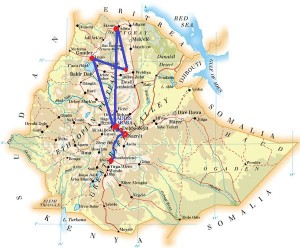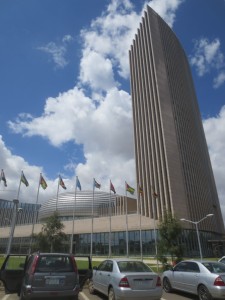More of Addis
After travelling to the north and the south of Addis with the tour (note the map), we wanted to explore more of Addis Ababa itself. We finished our work archiving MCC files several days early so we spent the last couple days of visiting sites in Addis.
We started our exploration by walking around the neighborhood. The house is located down a small rocky road on the side of a hill. At the top of the hill (about a 20-25 minute walk) is an Ethiopian Orthodox Church.
One afternoon we walked from the office to Meskel Square and on to the “Red Terror” museum. Meskel Square was important in the days of the Derg for that is where there were large military review parades. It is now a big bus/taxi station. The Derg (1974-91) was the socialist-inspired Military Coordinating Committee that ruled the country after the arrest of Emperor Haile Selassie. During Selassie’s time and during the Derg there were thousands of people killed. The “Red Terror Martyrs’ Memorial Museum” is in honor of all those killed. It was a sobering visit.
A highlight visit was to the new buildings for the African Union which were completed in 2012. What an impressive building! We were able to visit the grand hall which holds 2500 people and some of the smaller meeting halls. Ethiopia has been a center for the promotion of pan-Africanism since the early 1960’s.
We visited Addis Ababa Museum and Museum of the Institute of Ethiopian Studies. Both quite interesting. Addis Ababa Museum is housed in a former royal residence. There was a collection of old ceremonial and official clothes, documents, photos, artifacts. Imposing paintings of Emperor Menelik II and his wife Empress Taitu greeted us upon entering. Menelik II is considered the founder of modern day Addis.
The Museum of Ethiopian Studies is housed in the former palace of Emperor Haile Selassie on the grounds of the University of Addis Ababa. The first floor is dedicated to artifacts of the daily life of Ethiopian peoples from birth to death. The second floor is a selection of Ethiopian crosses and icons dating back to the Middle Ages.
We ended our exploring by eating a samosa from a street vendor, visiting the nearby leprosy and TB hospital gift shop, and riding in the ever-popular bajaj.
The travel home was tiring with little sleep during the 44 hours from Saturday morning until late Sunday night (with 7 hour time change). And we arrived to snow after experiencing perfect weather for 2 months—warm and sunny. But its good to be home!





































